SPOILERS! Here's a full breakdown of the post-credits scenes and what they mean for the MCU.
Major spoilers ahead, so proceed with caution. But if you've seen "Captain Marvel," then get in here. We've got a lot to talk about.
Captain, meet Captain.
There are a number of familiar -- albeit slightly younger -- faces in Captain Marvel, but nary an Avenger among them. It's not until the final moments of the movie that Nick Fury (Samuel L. Jackson) even begins to draft the first pitch for an Avengers Initiative, named for the Air Force call sign of Carol "Avenger" Danvers (Brie Larson). The first of the two end-credits codas, however, sees his plan come full circle, and below, ET breaks down both scenes.
The Mid-Credits Scene: Directly mirroring the final shot of the Avengers: Infinity War tag, this one starts with a close-up of Fury's pager -- the one we saw him send a distress signal on right before he was dusted. Over the course of this movie, we'd seen Carol confiscate, upgrade and return the pager to Fury in case of an emergency. Now, the pager is blinking in a laboratory setup.
"This is a nightmare," a bearded Captain America (Chris Evans) says as he watches the global death toll rise.
"I've had better nightmares." Black Widow (Scarlett Johansson) replies.
Rhodey (Don Cheadle) interrupts the lamenting to inform them that the pager "just stopped doing whatever the hell it was doing," and Cap directs Bruce Banner (Mark Ruffalo) to reboot it and send the signal again.
"We don't even know what this is!" Banner objects.
"Fury did. Just do it, please," Widow tells him. "And tell me the second you get a signal. I want to know who's on the other end of that thing."
She turns around and: It's Captain Marvel, together with the (remaining) Avengers for the first time. "Where's Fury?" Carol asks and the scene cuts to black. It happens so quickly that maybe you didn't clock that this Carol has longer hair or that her uniform is different, darker and with more gold. Some time has obviously passed since the end of Captain Marvel...but not 20 years.
So, how did Carol make her way to the present day? We've known for a while that she'd be in Endgame, and when I visited the set of Captain Marvel, Samuel L. Jackson seemingly let slip a massive clue about how that would come to be: Time travel.
"She's pretty much the strongest character -- in terms of someone with powers are able to do things -- in the Marvel universe," he said. "[The Avengers] are up against some really, really tough odds right now -- we saw throughout Infinity War -- so now we know that we need something that's as powerful as Thanos. And at some point, we'll find out how powerful she is and all the things that she's capable of. She's one of the few people in the Marvel universe that can time travel, so..."
His comment seemed wild at the time, as time travel was never one of Carol Danvers' signature powers in the comics. Having seen the movie, it's not so hard to believe the MCU's Carol would, considering this new take on her origin story has her inheriting her powers from the Tesseract's Space Stone. According to Marvel, the Stone "allows its user to exist in any location, move throughout different realities, warp or rearrange space [and] teleport across planes regardless of the laws of physics or magical barriers." It wouldn't be a stretch for that to include time, too.
Except Captain Marvel ends with no indication that Carol actually could travel through time. And then, during a recent appearance on KROQ, Jackson claimed that in order to avoid letting slip any spoilers, "I made stuff up. I said she could time travel one time." "Which was confusing for everyone," Larson chimed in.
(Larson doubled down on this during her WIRED Autocomplete Interview, saying, "No, I don't time travel. I understand it's a little confusing with the time-lapse, but like, she uses good skin care. Just don't worry about it.")
Which could be a troll on a troll, trolling us now to cover up for revealing something a bit premature then, but here's another theory: Goose. In addition to the tentacles on display in this movie, Flerken contain "pocket dimensions" that allow for dimensional travel through, theoretically, space and time. Although you imagine that if Goose had eaten Carol -- for time traveling purposes, only -- she would be a bit...gooier in the post-credits scene.
Thankfully, all will be revealed soon enough, as Endgame is out on April 26.

The End-Credits Scene: As has become customary with Marvel tags, the second stinger is more so a gag relating to something from the movie. This one adds context to the established mythos of Marvel's cinematic universe, but is mostly just a little something extra for the #GooseArmy.
The scene opens in Fury's seemingly empty office as Goose jumps up onto his desk and licks his paws, then starts to retch like he's going to cough up a hairball. But, of course, it's the Tesseract that comes out, covered in Flerken slime and landing with a thud on Fury's desk.
Following a brief tease during the end-credits scene of Thor, the Tesseract was properly introduced in Marvel's fifth film, Captain America: The First Avenger, which ends with Howard Stark (Dominic Cooper) fishing the Cube out of the ocean and ultimately relinquishing it to S.H.I.E.L.D. in the 1940s.
Now, Captain Marvel, the 21st installment in the MCU, fills in a stretch of the '80s and '90s when the S.H.I.E.L.D.-adjacent Project P.E.G.A.S.U.S. was granted access to the Tesseract for Dr. Wendy Lawson (aka Annette Bening's Mar-Vell) to experiment on a light-speed engine. The scene ends with the Cube back on Earth and in S.H.I.E.L.D.'s possession, where it will ostensibly remain until Loki steals it in The Avengers.
RELATED CONTENT:
